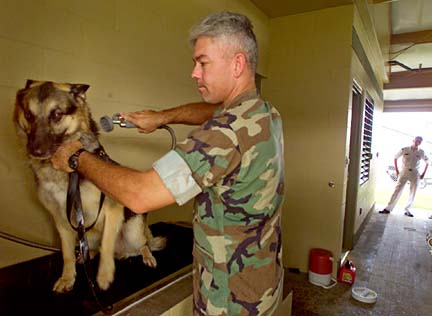
Heroes in the dog house
at Pearl HarborA new location gives Navy
trainers space to house and
handle the versatile hounds
Senior Chief Petty Officer Chris Ray got his wish for a vacant gravel parking lot at Pearl Harbor as a permanent home for the bomb-sniffing security dogs that protect Navy installations on Oahu.
"We've always shared kennels with Air Force at Hickam (Air Force Base) since 1985," said Ray, who has been Pearl Harbor's kennel master since he arrived here in 1999.
Ray, a 14-year Navy veteran, and his 12 dog handlers moved into their new kennels this summer.
For security reasons, Ray won't disclose the exact number of dogs, which were trained at Lackland Air Force Base in San Antonio, Texas, assigned to him. He did say the breeds include Dutch Shepherd, German Shepherd and a Belgium Malinois.
"The dogs have been have been trained to be either bomb or drug dogs," Ray said. "But they all can do attack functions, such as finding a person in the woods or in an office and attacking them on command."
"I would like to get a Jack Russell terrier," Ray added, "because of their small size. On the mainland they are used to search submarines and we got a lot of them here."
Today, there are about 1,400 military working dog teams in the Department of Defense worldwide. This year, about 350 canines, nearly double the regular intake, will go through a five-month-long training program at Lackland. The base is the only facility in the country that trains dogs for the Army, Navy, Air Force and Marine Corps.
Canines are certified in explosive detection and patrol, which means they will attack on command, or to protect themselves or their handler. After training, they are sent to military installations worldwide.
Planning for Navy Region Hawaii's 12 security kennels started in November. They cost $500,000 to construct.
"This location is good," Ray added. "It is close and easy to get to Halawa gate, and we can easily get out of here when we are called. There also is nothing close to interfere with our operations and the dogs' barking won't bother anybody."
Besides providing security protection at the gates leading to Pearl Harbor, Ray said his police force is responsible for duties at the Naval Magazine at Lualualei and the Naval Computer and Telecommunications Area Master Station in Wahiawa.
The new Pearl Harbor location also provides better access for his dog handlers, who normally pull 12-hour shifts.
"It's actually more like 14 hours," Petty Officer Robinson Lucero said, "because after we get off shift we still have to feed and care for the dogs."
But Lucero, 32, doesn't mind the long hours.
When he was first assigned to Pearl Harbor in 1997, Lucero was a dental technician. "I was put in an office and was just pushing papers."
A meeting with Ray changed all that. "I was always interested in field work," Lucero said. "It was outdoors, in the field and it wasn't just pushing papers."
He applied and was accepted to become a military policeman and spent four months at Lackland to qualify as a law enforcement officer and a dog handler, returning to Pearl Harbor in 2000.
Now Lucero, who has been in the Navy for 11 years, is preparing a one-year tour in Bahrain, beginning in December.
Lucero worked with a black Labrador until the dog died last year.
Last December, he was assigned to Rossi, a male 2-year-old Belgium Malinois, which had just completed its training at Lackland.
"The first day when he (Rossi) flew in I was off," Lucero said. "But I came in later in the day and gave him a bath, fed him and tried to get to know him better. At one point I looked him in the eye and asked him -- 'Hey, buddy, what are you going to do, chew my face off or be my friend?'"
Ray said a dog and his handler remain partners until the handler has to leave, generally after three years.
"We compare it to a breakup with your first childhood girlfriend," Ray noted, pointing out that a dog handler will stop working with his animal a month before he is scheduled to leave. "As time goes by, you forget her and move on."
Each dog handler is responsible for feeding, cleaning the cage, handing out treats, grooming and gradually building up a rapport with the dog.
"With all the training, medical and other care, these dogs are valued at about $50,000 to $60,000," Ray said.
Dogs undergo a stringent screening process, Ray said, adding that "only 10 percent of every 30 dogs tested" actually make it into the program.
Military working dogs have served in wars since 1939 as scouts, sentries, messengers, and much more.
During the Vietnam War, the U.S. War Dogs Association estimates, the animals and their handlers saved more than 10,000 lives.
